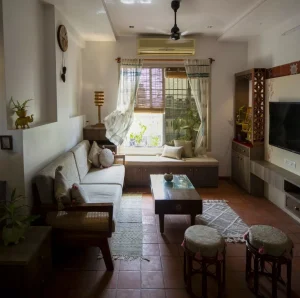
City living is a whirlwind. Between the hum of traffic and the glow of streetlights, it’s easy to feel disconnected from the natural world. But here’s the thing: transforming your apartment into a green sanctuary isn’t just a pipe dream for homeowners with backyards. In fact, creating a sustainable home in a high-rise is not only possible, it’s incredibly rewarding.
Let’s dive into some practical, eco-friendly upgrades that make a real difference. No major renovations required.
Start Small: The Low-Effort, High-Impact Swaps
You don’t need to overhaul your entire life overnight. Honestly, the best way to begin is with a few simple switches. These are the upgrades that build momentum.
Lighting: The Brilliantly Simple Switch
If you do one thing today, make it this. Swap out those old incandescent or CFL bulbs for LEDs. It’s a no-brainer. LEDs use at least 75% less energy and last 25 times longer. That’s a win for your wallet and the planet. Think of them as the quiet, reliable workhorses of your apartment’s ecosystem.
Power Strips: Slay the Phantom Load
Your electronics are sneaky. Even when “off,” they sip electricity—a phantom load that can account for up to 10% of your energy bill. The solution? Smart power strips. They cut power to devices that are in standby mode. Plug in your entertainment center, your computer setup, your charger hub… and just flip the switch when you’re not using them. It’s like putting your energy vampires on a diet.
Breathing Easy: Upgrades for Air and Water Quality
Urban air quality can be, well, less than ideal. And the water? It might be legal, but that doesn’t mean it’s as pure as you’d like. Let’s tackle that.
Indoor Air Purification with Plants
Houseplants are more than just décor. They’re your silent, leafy roommates that filter common volatile organic compounds (VOCs) from your air. You don’t need a jungle. Start with a few hard-to-kill varieties.
- Snake Plant: A true champion. It thrives on neglect and converts CO2 into oxygen at night, making it perfect for the bedroom.
- Spider Plant: A resilient option that’s fantastic at battling pollutants like formaldehyde and xylene.
- Peace Lily: Elegant and effective, it helps reduce ammonia and benzene levels. Just a heads-up, it’s toxic to pets, so place it carefully.
Water Filtration: Skip the Bottles
Buying plastic water bottles is an environmental nightmare. A simple water filter pitcher is a great start, but for a more permanent sustainable home solution, consider an under-sink or countertop filtration system. The initial cost is offset by the sheer amount of plastic and money you’ll save. The taste is better, too. It’s one of those upgrades you’ll wonder how you ever lived without.
The Energy & Waste Frontier
This is where your eco-friendly apartment really starts to shine. We’re talking about systems and habits that create long-term sustainability.
Smart Thermostats for Renters
Think you can’t install a Nest because you’re renting? Think again. Newer models like the Ecobee Smart Thermostat Premium or portable smart AC controllers are designed for apartments. They learn your schedule and adjust the temperature when you’re out, saving a bundle on heating and cooling. It’s like having a tiny, energy-conscious butler.
Mastering the Art of Waste Reduction
Reducing waste in a small space is a creative challenge. It’s about systems. Start with a simple sorting station for recycling and compost. Many cities now offer compost pickup, but if yours doesn’t, a small countertop compost bin works wonders for food scraps (and reduces stinky trash).
And then there’s the shopping. Embrace the bulk aisle with your own jars and bags. Choose products with minimal or recyclable packaging. It feels good, you know? To not be drowning in plastic wrap and cardboard every time you unpack groceries.
Material World: Conscious Consumerism at Home
The stuff we bring into our homes matters. Its origin, its material, its lifespan—it all tells a story.
Choosing Sustainable Materials
When you need a new item, pause. Ask where it comes from. Look for secondhand first—that’s the ultimate eco-friendly home upgrade. When buying new, seek out materials that are renewable, recycled, or built to last.
| Material | Why It’s a Good Choice | Look For… |
| Bamboo | Grows incredibly fast, requires no pesticides, and is naturally antimicrobial. | Cutting boards, utensils, bedding, furniture. |
| Recycled Glass | Gives a second life to glass waste, reducing landfill use and energy consumption. | Countertops (for owners), drinking glasses, decor. |
| Organic Cotton & Linen | Grown without toxic pesticides, uses less water than conventional cotton. | Towels, sheets, curtains, upholstery. |
| Reclaimed Wood | Prevents deforestation and adds unique character with a history. | Floating shelves, coffee tables, headboards. |
Textiles and Soft Furnishings
Your couch, your rug, your curtains—they all hold the potential for a greener home. Opt for natural fiber rugs like jute or wool over synthetic ones. Choose organic cotton or linen for your bedding. These materials are not only better for the environment, they often feel better against your skin and help regulate temperature. A small but significant luxury.
Wrapping It Up: The Ripple Effect
Transforming your urban apartment into an eco-friendly haven isn’t about achieving perfection. It’s about a series of conscious choices. It’s about that LED bulb you screwed in, the power strip you finally started using, the reusable coffee cup that now feels like a part of your hand.
Each small action creates a ripple. It changes your relationship with your space, with your resources, with the city around you. And honestly, that collective ripple from thousands of apartments? That’s how real, urban-scale change begins. Right on your windowsill.








